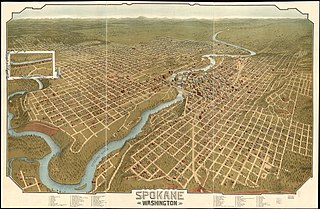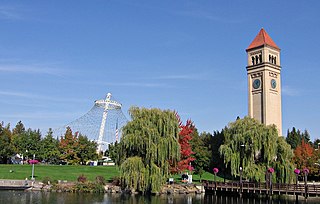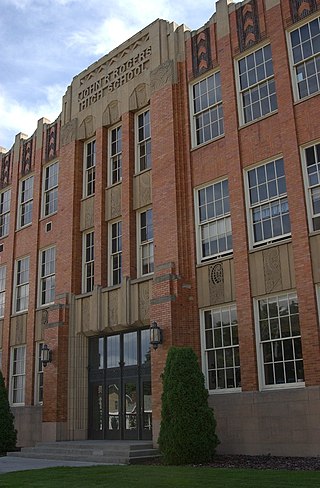
Spokane is the most populous city in and the county seat of Spokane County, Washington, United States. It is in eastern Washington, along the Spokane River, adjacent to the Selkirk Mountains, and west of the Rocky Mountain foothills, 92 miles (148 km) south of the Canadian border, 18 miles (30 km) west of the Washington–Idaho border, and 279 miles (449 km) east of Seattle, along Interstate 90.

Spokane Transit Authority, more commonly Spokane Transit or STA, is the public transport authority of central Spokane County, Washington, United States, serving Spokane, Washington, and its surrounding urban areas. In 2023, the system had a ridership of 9,215,700, or about 34,400 per weekday as of the first quarter of 2024.

Houston Public Library is the public library system serving Houston, Texas, United States.

The Atlanta–Fulton Public Library System is a network of public libraries serving the City of Atlanta and Fulton County, both in the U.S. state of Georgia. The system is administered by Fulton County. The system is composed of the Atlanta Central Library in Downtown Atlanta, which serves as the library headquarters, as well as the Auburn Avenue Research Library on African American Culture and History, and 33 branch libraries.

Hillyard is a neighborhood in Spokane, Washington which existed as a separate town between 1892 and 1924. The town came about due to the Great Northern Railway and was named for James J. Hill, then-head of the railroad. Between 1904 and 1912, many of the town's houses were built to house railroad workers working in the local yard. Hillyard was the home of the Great Northern's famed shops where locomotives were manufactured, repaired, and refurbished. At the time, the Hillyard shop was the largest in the nation.

John R. Rogers High School is a four-year public secondary school in Bemiss, Spokane, Washington, part of Spokane Public Schools. Opened in 1932 in northeast Spokane, the school is named after John Rankin Rogers, the third governor of the State of Washington.

Neighborhoods in Spokane, Washington are officially grouped by the Spokane City Council into three main city council districts: 1, 2, and 3. Each city council district contains multiple, official neighborhoods that are recognized with a neighborhood council. Informally, neighborhoods are colloquially grouped by local geographical, geological, cultural, or historical features The list of neighborhoods below is organized based on the official designations by the City of Spokane. Unofficial neighborhoods and districts are listed within the official neighborhood in which they are located.

Downtown Spokane or Riverside is the central business district of Spokane, Washington. The Riverside neighborhood is roughly bounded by I-90 to the south, Division Street to the east, Monroe Street to the west and Boone Avenue to the north. The topography of Downtown Spokane is mostly flat except for areas downstream of the Spokane Falls which are located in a canyon; the elevation is approximately 1,900 feet (580 m) above sea level.

Dayton Metro Library is a multi-branch library system serving 531,687 residents of the Dayton Metropolitan Area. It has 19 locations across the area. Almost 5.8 million items were borrowed in 2018. The Dayton Metro Library ranks in the top ten best libraries in the United States serving a population of over 250,000 by HAPLR. The Dayton Metro Library system is considered a county system with branches in cities and towns throughout Montgomery County, Ohio, but does not have branches in Centerville, Germantown, Oakwood, Riverside or Washington Township. All are serviced by libraries of their own, save Riverside, various parts of which are geographically close to Dayton Metro Library locations, including Burkhardt, Electra C. Doren and Huber Heights.

The Hillsboro Public Library is a two-location public library system in Hillsboro, Oregon, United States. First opened in 1914 in a Carnegie library building, the system provides services to a population area of 137,000 people. As of 2015, the system had a usage of 922,000 visits per year, with circulation nearly 3 million items per year. One library is located near downtown in Shute Park, with the other location in the central portion of the city near the airport. The Hillsboro Public Library is part of Washington County Cooperative Library Services (WCCLS), which ensures library service is available to all residents of Washington County. As of 2015, the director of the library is Stephanie Chase.

River Park Square is a shopping mall and entertainment complex in Spokane, Washington. The shopping center was originally opened in 1974. Following years of decline, the center was redeveloped in 1999 using public and private funds in an effort to revitalize downtown Spokane. The mall, still privately owned by Cowles Company, is anchored by Nordstrom and contains an outpost of AMC Theatres.

Riverfront Park, branded as Riverfront Spokane, is a public urban park in downtown Spokane, Washington that is owned and operated by the Spokane Parks & Recreation Department. The 100-acre (40 ha) park is situated along the Spokane River and encompasses the Upper Spokane Falls, which is the largest urban waterfall in the United States.

Shadle Park High School is a four-year public secondary school in the northwest United States, located in the Audubon/Downriver neighborhood of Spokane, Washington. Northwest of downtown Spokane, Shadle Park was the first new high school in the city in a quarter century when it opened 67 years ago in 1957. Part of Spokane Public Schools, it had an enrollment of 1,348 students in 2019.

The Boulder Public Library is the public library of Boulder, Colorado in the United States. The main branch and the Carnegie Branch Library for Local History are located in downtown Boulder. The George Reynolds Branch is in south Boulder, Meadows Branch is in east Boulder, and the North Boulder Branch, also called NoBo, is in north Boulder.

The STA Plaza, is a transit center located in Downtown Spokane, Washington. It is the main hub of customer service and transit operations for the Spokane Transit Authority (STA), with 31 out of its 52 bus routes connecting with The Plaza. Transit operations through the Plaza resemble that of an airline hub, with bays of buses arriving and departing in waves, providing timed transfer opportunities for passengers.

Bemiss is a neighborhood in Spokane, Washington. It is located within City Council District 1, which covers the northeastern section of the city. The neighborhood is bounded by Wellesley Avenue to the north, Market Street to the east, Illinois Avenue and the Spokane River to the south, and Perry Street and Napa Street to the west. It is located to the southeast of the Hillyard neighborhood and is often grouped into greater Hillyard.

Spokane and its neighborhoods contain a patchwork of architectural styles that give them a distinct identity and illustrate the changes throughout the city's history. Spokane has a rich architectural history for a western city of its size and much of it is a product of its circumstances at the turn of the 20th century when as a rapidly growing city, the Great Fire of 1889 destroyed 32 blocks of the city center which was quickly rebuilt in a more grand fashion by a community flush with money coming from regional mining districts. Many of the architects that found work in the city and building on the blank slate of the downtown commercial district became highly esteemed architects such as Kirtland Cutter, who has been credited with giving the city a distinctive character. In particular, the city has a high concentration of Romanesque Revival style institutional and commercial buildings and American Craftsman bungalow residences. The architecture of Spokane gained national recognition in industry publications in the early 20th century.

Comstock is a neighborhood in Spokane, Washington. It is located on the south side of the city in a broader area commonly known as the South Hill. The neighborhood is primarily single-family residential, and a mix of homes built during the streetcar era and then built during the post-World War II housing boom. The neighborhood is also home to a few commercial districts, including the regionally important Manito Shopping Center, two schools, the eponymous Comstock Park, sports fields and a golf course.

Audubon/Downriver is a neighborhood in Spokane, Washington, located on the northwest side of the city. There is a diversity of land use in the neighborhood, with single-family residential areas dating from the early 20th century through the Post–World War II economic expansion era, regionally important commercial districts, smaller neighborhood retail areas, numerous schools, large parks, a golf course, conservation areas and part of Riverside State Park along the Spokane River. The neighborhood is the site of the corporate offices for Rosauers Supermarkets, a regional grocery store chain with stores located across the Northwestern United States.

One Spokane Stadium is a multi-use stadium in downtown Spokane, Washington, United States. It is home to the professional soccer teams Spokane Velocity of USL League One and Spokane Zephyr FC of the USL Super League and USL W League, as well as Spokane Public Schools high school teams in several sports. Opened in September 2023, it succeeds Joe Albi Stadium, the city's football and soccer venue from 1950 through 2021.























